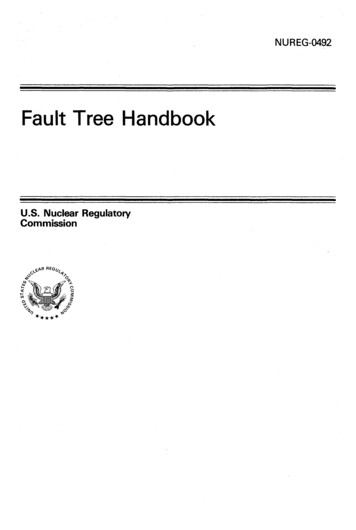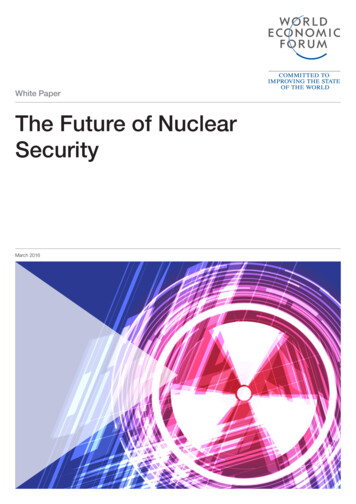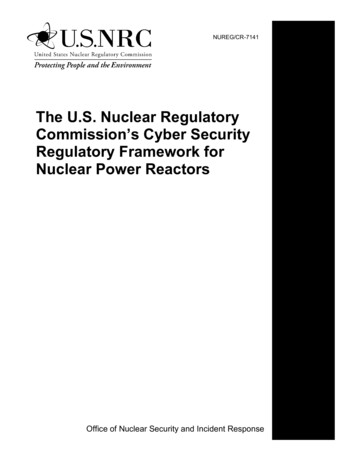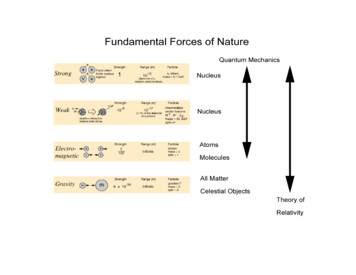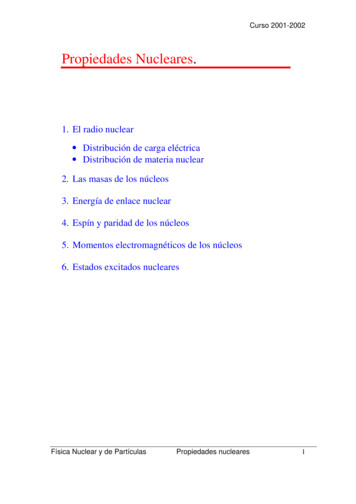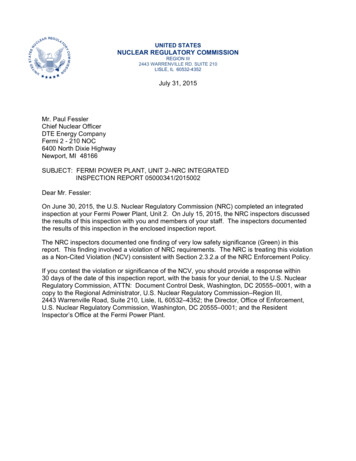
Transcription
UNITED STATESNUCLEAR REGULATORY COMMISSIONREGION III2443 WARRENVILLE RD. SUITE 210LISLE, IL 60532-4352July 31, 2015Mr. Paul FesslerChief Nuclear OfficerDTE Energy CompanyFermi 2 - 210 NOC6400 North Dixie HighwayNewport, MI 48166SUBJECT: FERMI POWER PLANT, UNIT 2–NRC INTEGRATEDINSPECTION REPORT 05000341/2015002Dear Mr. Fessler:On June 30, 2015, the U.S. Nuclear Regulatory Commission (NRC) completed an integratedinspection at your Fermi Power Plant, Unit 2. On July 15, 2015, the NRC inspectors discussedthe results of this inspection with you and members of your staff. The inspectors documentedthe results of this inspection in the enclosed inspection report.The NRC inspectors documented one finding of very low safety significance (Green) in thisreport. This finding involved a violation of NRC requirements. The NRC is treating this violationas a Non-Cited Violation (NCV) consistent with Section 2.3.2.a of the NRC Enforcement Policy.If you contest the violation or significance of the NCV, you should provide a response within30 days of the date of this inspection report, with the basis for your denial, to the U.S. NuclearRegulatory Commission, ATTN: Document Control Desk, Washington, DC 20555–0001, with acopy to the Regional Administrator, U.S. Nuclear Regulatory Commission–Region III,2443 Warrenville Road, Suite 210, Lisle, IL 60532–4352; the Director, Office of Enforcement,U.S. Nuclear Regulatory Commission, Washington, DC 20555–0001; and the ResidentInspector’s Office at the Fermi Power Plant.
P. Fessler-2-In accordance with Title 10 of the Code of Federal Regulations (10 CFR) 2.390, “PublicInspections, Exemptions, Requests for Withholding,” of the NRC's "Rules of Practice," a copyof this letter, its enclosure, and your response (if any) will be available electronically for publicinspection in the NRC Public Document Room or from the Publicly Available Records System(PARS) component of NRC's Agencywide Document Access and Management System(ADAMS), accessible from the NRC Website at http://www.nrc.gov/reading-rm/adams.html(the Public Electronic Reading Room).Sincerely,/RA/Michael A. Kunowski, ChiefBranch 5Division of Reactor ProjectsDocket No. 50–341License No. NPF–43Enclosure:IR 05000341/2015002w/Attachment: Supplemental Informationcc w/encl: Distribution via LISTSERV
U.S. NUCLEAR REGULATORY COMMISSIONREGION IIIDocket No:50–341License No:NPF–43Report No:05000341/2015002Licensee:DTE Energy CompanyFacility:Fermi Power Plant, Unit 2Location:Newport, MIDates:April 1 through June 30, 2015Inspectors:B. Kemker, Senior Resident InspectorP. Smagacz, Resident InspectorS. Bell, Health PhysicistJ. Jandovitz, Project EngineerJ. Wojewoda, Reactor EngineerApproved by:M. Kunowski, ChiefBranch 5Division of Reactor ProjectsEnclosure
TABLE OF CONTENTSSUMMARY OF FINDINGS . 2REPORT DETAILS . 3Summary of Plant Status . 31.REACTOR SAFETY . 31R01Adverse Weather Protection (71111.01) . 31R04Equipment Alignment (71111.04) . 51R05Fire Protection (71111.05) . 61R11Licensed Operator Requalification Program (71111.11) . 71R12Maintenance Effectiveness (71111.12) . 81R13Maintenance Risk Assessments and Emergent Work Control (71111.13) . 91R15Operability Determinations and Functionality Assessments (71111.15) . 101R18Plant Modifications (71111.18) . 111R19Post-Maintenance Testing (71111.19) . 111R22Surveillance Testing (71111.22) . 121EP6Drill Evaluation (71114.06). 132.RADIATION SAFETY . 142RS3 In-Plant Airborne Radioactivity Control and Mitigation (71124.03) . 142RS4 Occupational Dose Assessment (71124.04) . 184.OTHER ACTIVITIES . 234OA1 Performance Indicator Verification (71151) . 234OA2 Identification and Resolution of Problems (71152) . 254OA3 Follow-up of Events and Notices of Enforcement Discretion (71153) . 264OA6 Management Meetings . 28SUPPLEMENTAL INFORMATION . 1Key Points of Contact . 1List of Items Opened, Closed, and Discussed . 2List of Documents Reviewed . 3List of Acronyms Used . 13
SUMMARY OF FINDINGSInspection Report 05000341/2015002; 04/01/2015–06/30/2015; Fermi Power Plant, Unit 2;In-Plant Airborne Radioactivity Control and Mitigation.This report covers a 3-month period of inspection by resident inspectors and announcedbaseline inspections by regional inspectors. One Green finding, which had an associatedNon-Cited Violation (NCV) of the U.S. Nuclear Regulatory Commission (NRC) regulations, wasidentified. The significance of inspection findings is indicated by their color (i.e., greater thanGreen, or Green, White, Yellow, Red) and determined using Inspection Manual Chapter(IMC) 0609, “Significance Determination Process,” dated April 29, 2015. Cross-cutting aspectsare determined using IMC 0310, “Aspects Within the Cross-Cutting Areas,” datedDecember 4, 2014. All violations of NRC requirements are dispositioned in accordance with theNRC’s Enforcement Policy, dated February 4, 2015. The NRC's program for overseeing thesafe operation of commercial nuclear power reactors is described in NUREG–1649, “ReactorOversight Process,” dated February 2014.Cornerstone: Occupational Radiation SafetyGreen. The inspectors identified a finding of very low safety significance and associatedNon-Cited Violation of 10 CFR 20.1703(c)(4)(vii) for the licensee’s failure to implementand maintain procedures for its Mine Safety Appliance (MSA) Ultralite Self-ContainedBreathing Apparatus (SCBA) respirators. The SCBA respirators, in question, wereamong the population of SCBA units available for use but were not within the overhaulfrequency specified by the manufacturer; nor was the overhaul frequency addressed bythe licensee’s procedure. Immediate corrective actions included the removal fromservice of those respirators for which the required maintenance was not complete. Thishas been entered into the licensee’s corrective action program as CARD 15–23510,“CLO - Overdue Rebuild Requirement on Spare Regulators,” dated May 19, 2015.In accordance with Inspection Manual Chapter (IMC) 0612, Appendix B, “IssueScreening,” the inspectors determined the performance deficiency was of more thanminor significance because it was associated with the Program and Process attribute ofthe Occupational Radiation Safety Cornerstone, and adversely affected the cornerstoneobjective of ensuring the adequate protection of the workers’ health and safety fromexposure to radiation from radioactive material during routine civilian nuclear reactoroperation. Specifically, the failure to maintain a program or process that drives theperformance of required periodic maintenance could have resulted in the SCBA notperforming its intended function. Using IMC 0609, Appendix C, “Occupational RadiationSafety Significance Determination Process,” the inspectors determined the finding had avery low safety significance (Green) because the finding: (1) did not involveas-low-as-is-reasonably-achievable planning and controls; (2) did not involve aradiological overexposure; (3) there was not a substantial potential for an overexposure;and (4) there was no compromised ability to assess dose. These SCBAs are scheduledfor near term replacement with a newer model. The inspectors reviewed theimplementation for the new model and determined that an adequate maintenanceprogram has been established. No cross-cutting aspect was assigned because theperformance deficiency was not reflective of current performance. (Section 2RS3)2
REPORT DETAILSSummary of Plant StatusFermi Power Plant, Unit 2, was shut down at the start of the inspection period to completemaintenance following an automatic reactor scram on March 19. On April 3, the licenseeperformed a reactor startup and synchronized the unit to the electrical grid on April 4,completing a 15-day forced outage. The unit reached 100 percent power on April 6 and wasoperated at or near full power during the inspection period with the following exceptions: On June 27, the licensee reduced power to about 70 percent to perform a control rodpattern adjustment and main turbine control, stop, and bypass valve testing. The unitwas returned to 100 percent power on June 28. On June 29, the licensee reduced power to about 80 percent to perform an additionalcontrol rod pattern adjustment. The unit was returned to 100 percent power on June 30.1.REACTOR SAFETYCornerstones: Initiating Events, Mitigating Systems, Barrier Integrity, andEmergency Preparedness1R01 Adverse Weather Protection (71111.01).1a.Readiness of Offsite and Alternate AC [Alternating Current] Power SystemsInspection ScopeThe inspectors evaluated the licensee’s plant features and procedures for operation andcontinued availability of offsite and alternate AC power systems. The inspectorsinterviewed plant personnel and reviewed the licensee’s communications protocolsbetween the Transmission System Operator (TSO) and the plant to verify theappropriate information was being exchanged when issues arose that could impact theoffsite power system. Aspects considered in the inspectors’ review included: The actions to be taken when notified by the TSO that the post-trip voltage of theoffsite power system at the plant will not be acceptable to assure the continuedoperation of the safety-related loads without transferring to the onsite powersupply;The compensatory actions identified to be performed if it is not possible to predictthe post-trip voltage at the plant for the current grid conditions;The required re-assessment of plant risk based on maintenance activities thatcould affect grid reliability, or the ability of the transmission system to provideoffsite power; andThe required communications between the plant and the TSO when changes atthe plant could impact the transmission system, or when the capability of thetransmission system to provide adequate offsite power is challenged.During the week of May 18 through 22, the inspectors performed a walkdown of theswitchyards to observe the material condition of the offsite power sources and alsoreviewed the status of outstanding work orders (WOs) to assess whether corrective3
actions for any degraded conditions were scheduled with the TSO with the appropriatepriority.In addition, the inspectors verified problems associated with the availability and reliabilityof the offsite and alternate AC power systems were entered into the licensee’s correctiveaction program with the appropriate characterization and significance. Selectedcondition assessment resolution documents (CARDs) were reviewed to verify correctiveactions were appropriate and implemented as scheduled. Documents reviewed arelisted in the Attachment to this report.This inspection constituted one offsite and alternate AC power systems readinessinspection sample as defined in Inspection Procedure (IP) 71111.01.b.FindingsNo findings were identified.2a.Readiness for Impending Hot Summer Weather ConditionsInspection ScopeThe inspectors evaluated the licensee’s preparations for hot summer weather conditions,focusing on the Supplemental Cooling Water (SCS), Residual Heat Removal ServiceWater (RHRSW), Emergency Equipment Service Water (EESW), and Diesel GeneratorService Water systems. During the week of May 31 through June 6, the inspectorsperformed a detailed review of severe weather and plant de-winterization proceduresand performed general area plant walkdowns. The inspectors focused on plant specificdesign features and implementation of procedures for responding to or mitigating theeffects of hot summer weather conditions on the operation of the plant. The inspectorsreviewed system health reports and system engineering summer readiness reviewdocuments for the above systems.In addition, the inspectors verified adverse weather-related problems were entered intothe licensee’s corrective action program with the appropriate characterization andsignificance. Selected CARDs were reviewed to verify corrective actions wereappropriate and implemented as scheduled. Documents reviewed are listed in theAttachment to this report.This inspection constituted one seasonal extreme weather readiness inspection sampleas defined in IP 71111.01.b.FindingsNo findings were identified.3a.External FloodingInspection ScopeThe inspectors reviewed flood protection barriers and procedures for coping withexternal flooding at the plant. The inspectors reviewed Section 3.4 of the Updated FinalSafety Analysis Report (UFSAR) and Section 5.2 of the Individual Plant Examination ofExternal Events Report to understand the susceptibility of the plant to external flooding4
and the design features to mitigate the consequences of external flooding events. Theinspectors reviewed Abnormal Operating Procedure 20.000.01, “Acts of Nature,”Revision 48, to assess the adequacy of the licensee’s response to external floodingconditions.The inspectors conducted a walkdown of the Residual Heat Removal (RHR)/EmergencyDiesel Generator (EDG) Complex and Auxiliary Building, including the roofs. Theinspectors assessed the condition of roof drains and scuppers; the sealing of water-tightdoors, equipment floor plugs, electrical conduits, and holes or penetrations in theexterior walls below flood grade; and the condition of room floor drains, sumps, andsump pumps.Additionally, the inspectors verified external flooding protection related problems wereentered into the licensee’s corrective action program with the appropriatecharacterization and significance. Selected CARDs were reviewed to verify correctiveactions were appropriate and implemented as scheduled. Documents reviewed arelisted in the Attachment to this report.This inspection constituted one external flooding readiness inspection sample as definedin IP 71111.01.b.FindingsNo findings were identified.1R04 Equipment Alignment (71111.04).1a.Quarterly Partial System Walkdowns (71111.04Q)Inspection ScopeThe inspectors performed partial system walkdowns of the following risk significantsystems: High Pressure Coolant Injection (HPCI) (Single Train Risk Significant System);Division 1 EESW Subsystem during Division 2 EESW Pump Replacement; andDivision 2 Core Spray (CS) Subsystem during Division 1 CS SubsystemMaintenance.The inspectors selected these systems based on their risk significance relative to theReactor Safety Cornerstones. The inspectors reviewed operating procedures, systemdiagrams, Technical Specification (TS) requirements, and the impact of ongoing workactivities on redundant trains of equipment in order to identify conditions that could haverendered the systems incapable of performing their intended functions. The inspectorsalso walked down accessible portions of the systems to verify system components andsupport equipment were aligned correctly and were available. The inspectors observedoperating parameters and examined the material condition of the equipment to verifythere were no obvious deficiencies.In addition, the inspectors verified equipment alignment related problems were enteredinto the licensee’s corrective action program with the appropriate characterization andsignificance. Selected CARDs were reviewed to verify corrective actions were5
appropriate and implemented as scheduled. Documents reviewed are listed in theAttachment to this report.This inspection constituted three partial system walkdown inspection samples as definedin IP 71111.04.b.FindingsNo findings were identified.1R05 Fire Protection (71111.05).1a.Routine Resident Inspector Tours (71111.05Q)Inspection ScopeThe inspectors conducted fire protection walkdowns that were focused on availability,accessibility, and the condition of firefighting equipment in the following risk significantplant areas: Onsite Storage Facility;Auxiliary Building Fifth Floor, Division 1 Control Center Heating, Ventilation, andAir Conditioning (CCHVAC) Room;Reactor Building Third Floor, East Side and Standby Liquid Control; andAuxiliary Building Third Floor, Division 2 Switchgear Room.The inspectors reviewed these fire areas to assess if the licensee had implemented aFire Protection Program that adequately controlled combustibles and ignition sourceswithin the plant; effectively maintained fire detection and suppression capability;maintained passive fire protection features in good material condition; and implementedadequate compensatory measures for out-of-service, degraded, or inoperable fireprotection equipment, systems, or features in accordance with the licensee’s FireProtection Plan. The inspectors selected fire areas based on their overall contribution tointernal fire risk as documented in the plant’s Individual Plant Examination of ExternalEvents Report with later additional insights, their potential to impact equipment thatcould initiate or mitigate a plant transient, or their impact on the plant’s ability to respondto a security event. The inspectors verified fire hoses and extinguishers were in theirdesignated locations and available for immediate use; fire detectors and sprinklers wereunobstructed; transient material loading was within the analyzed limits; and fire doors,dampers, and penetration seals appeared to be in satisfactory condition.In addition, the inspectors verified fire protection related problems were entered into thelicensee’s corrective action program with the appropriate characterization andsignificance. Selected CARDs were reviewed to verify corrective actions wereappropriate and implemented as scheduled. Documents reviewed are listed in theAttachment to this report.This inspection constituted four quarterly fire protection inspection samples as defined inIP 71111.05AQ.6
b.FindingsNo findings were identified.2a.Annual Fire Protection Drill Observation (71111.05A)Inspection ScopeOn May 5, the inspectors observed fire brigade activation for a fire drill in the MainTurbine Generator Area. Based on this observation, the inspectors evaluated thereadiness of the plant fire brigade to fight fires. The inspectors verified the licenseeidentified deficiencies; openly discussed them in a self-critical manner at the drill debrief;and took appropriate corrective actions. Specific attributes evaluated were: proper wearing of turnout gear and Self-Contained Breathing Apparatus (SCBA);proper use and layout of fire hoses;employment of appropriate firefighting techniques;sufficient firefighting equipment brought to the scene;effectiveness of fire brigade leader communications, command, and control;search for victims and propagation of the fire into other plant areas;smoke removal operations;utilization of pre-planned strategies;adherence to the pre-planned drill scenario; anddrill objectives.Documents reviewed are listed in the Attachment to this report.This inspection constituted one annual fire protection drill inspection sample as definedin IP 71111.05AQ.b.FindingsNo findings were identified.1R11 Licensed Operator Requalification Program (71111.11).1a.Resident Inspector Quarterly Review of Licensed Operator RequalificationInspection ScopeThe inspectors observed licensed operators during evaluated simulator training onJune 11. The inspectors assessed the operators’ response to the simulated eventsfocusing on alarm response, command and control of crew activities, communicationpractices, procedural adherence, and implementation of Emergency Plan requirements.The inspectors also observed the post-training critique to assess the ability of thelicensee’s evaluators and the operating crew to self-identify performance deficiencies.The crew’s performance in these areas was compared to pre-established operator actionexpectations and successful critical task completion requirements. Documents reviewedare listed in the Attachment to this report.This inspection constituted one quarterly licensed operator requalification programsimulator inspection sample as defined in IP 71111.11.7
b.FindingsNo findings were identified.2a.Resident Inspector Quarterly Observations During Periods of Heightened Activity or Risk(71111.11Q)Inspection ScopeOn April 3, the inspectors observed licensed operators in the Control Room perform areactor start up following a forced maintenance outage. This activity requiredheightened awareness, additional detailed planning, and involved increased operationalrisk. The inspectors evaluated the following areas: licensed operator performance;crew’s clarity and formality of communications;ability to take timely actions in the conservative direction;prioritization, interpretation, and verification of annunciator alarms;correct use and implementation of procedures;control board (or equipment) manipulations;oversight and direction from supervisors; andability to identify and implement appropriate TS actions.The performance in these areas was compared to pre-established operator actionexpectations, procedural compliance, and task completion requirements.In addition, the inspectors verified licensed operator performance related problems wereentered into the licensee’s corrective action program with the appropriatecharacterization and significance. Selected CARDs were reviewed to verify correctiveactions were appropriate and implemented as scheduled. Documents reviewed arelisted in the Attachment to this report.This inspection constituted one quarterly licensed operator heightened activity/riskinspection sample as defined in IP 71111.11.b.FindingsNo findings were identified.1R12 Maintenance Effectiveness (71111.12)a.Inspection ScopeThe inspectors evaluated the licensee's handling of selected degraded performanceissues involving the following risk significant structures, systems, and components(SSCs): Process Radiation Monitoring System; andNumber 2 High Pressure Stop Valve (HPSV).8
The inspectors assessed performance issues with respect to the reliability, availability,and condition monitoring of the SSCs. Specifically, the inspectors independently verifiedthe licensee's handling of SSC performance or condition problems in terms of: appropriate work practices;identifying and addressing common cause failures;scoping of SSCs in accordance with Title 10 of the Code of Federal Regulations(10 CFR) 50.65(b);characterizing SSC reliability issues;tracking SSC unavailability;trending key parameters (condition monitoring);10 CFR 50.65(a)(1) or (a)(2) classification and reclassification; andappropriateness of performance criteria for SSC functions classified (a)(2) and/orappropriateness and adequacy of goals and corrective actions for SSC functionsclassified (a)(1).In addition, the inspectors verified problems associated with the effectiveness of plantmaintenance for risk significant SSCs were entered into the licensee's corrective actionprogram with the appropriate characterization and significance. Selected CARDs werereviewed to verify corrective actions were appropriate and implemented as scheduled.Documents reviewed are listed in the Attachment to this report.This inspection constituted two quarterly maintenance effectiveness inspection samplesas defined in IP 71111.12.b.FindingsNo findings were identified.1R13 Maintenance Risk Assessments and Emergent Work Control (71111.13)a.Inspection ScopeThe inspectors reviewed the licensee's evaluation and management of plant risk formaintenance and emergent work activities affecting risk significant and/or safety relatedequipment listed below to verify the appropriate risk assessments were performed priorto removing equipment for work: Planned maintenance during the week of April 20 through 24 including EDG 12surveillance testing and General Service Water Building diving activities;Planned maintenance during the week of April 27 through May 1 includingEDG 14 safety system outage;Planned maintenance during the week of May 4 through 8 including Division 2EESW Pump replacement and emergent work on Division 2 CCHVACsubsystem;Planned maintenance during the week of May 24 through 30 including Division 2RHR/ RHRSW subsystem and HPCI system testing; andPlanned maintenance during the week of June 15 through 19 including Division 1CS subsystem maintenance.9
These activities were selected based on their potential risk significance relative to theReactor Safety Cornerstones. As applicable for each of the above activities, theinspectors reviewed the scope of maintenance work in the plant’s daily schedule,reviewed Control Room logs, verified plant risk assessments were completed asrequired by 10 CFR 50.65(a)(4) prior to commencing maintenance activities, discussedthe results of the assessment with the licensee’s Probabilistic Risk Analyst and/or ShiftTechnical Advisor, and verified plant conditions were consistent with the risk assessmentassumptions. The inspectors also reviewed TS requirements and walked down portionsof redundant safety systems, when applicable, to verify risk analysis assumptions werevalid, redundant safety related plant equipment necessary to minimize risk was availablefor use, and applicable requirements were met.In addition, the inspectors verified maintenance risk related problems were entered intothe licensee's corrective action program with the appropriate characterization andsignificance. Selected CARDs were reviewed to verify corrective actions wereappropriate and implemented as scheduled. Documents reviewed are listed in theAttachment to this report.This inspection constituted five maintenance risk assessment and emergent work controlinspection samples as defined in IP 71111.13.b.FindingsNo findings were identified.1R15 Operability Determinations and Functionality Assessments (71111.15)a.Inspection ScopeThe inspectors reviewed the following issues: CARD 15–21350, Reactor Building Heating, Ventilation, and Air ConditioningSystem (RBHVAC) Tripped from Freeze-Stat H;CARD 14–21236, Results from the BADGER Test Report Indicate Three FuelStorage Rack Panels Have Boron Density Less Than That Assumed; andCARD 15–24202, Water Spray Due to High Humidity from Room CoolerSpraying on HPCI Turbine Components.The inspectors selected these potential operability/functionality issues based on thesafety significance of the associated components and systems. The inspectors verifiedthe conditions did not render the associated equipment inoperable/non-functional orresult in an unrecognized increase in plant risk. When applicable, the inspectors verifiedthe licensee appropriately applied TS limitations, appropriately returned the affectedequipment to an operable or functional status, and reviewed the licensee’s evaluation ofthe issue with respect to the regulatory reporting requirements. Where compensatorymeasures were required to maintain operability, the inspectors determined whether themeasures in place would function as intended and were properly controlled. Whenapplicable, the inspectors also verified the licensee appropriately assessed thefunctionality of SSCs that perform specified functions described in the UFSAR, TechnicalRequirements Manual, Emergency Plan, Fire Protection Plan, regulatory commitments,or other elements of the current licensing basis when degraded or nonconformingconditions were identified.10
In addition, the inspectors verified problems associated with the operability orfunctionality of safety-related and risk significant plant equipment were entered into thelicensee’s corrective action program with the appropriate characterization andsignificance. Selected CARDs were reviewed to verify corrective actions wereappropriate and implemented as scheduled. Documents reviewed are listed in theAttachment to this report.This inspection constituted three operability determination and functionality assessmentinspection samples as defined in IP 71111.15.b.FindingsNo findings were identified.1R18 Plant Modifications (71111.18).1a.Temporary ModificationsInspection ScopeThe inspectors reviewed the following plant Temporary Modifications (TMs): TM 13–0033, Monitor the A71BK010D and A71BK007D Trip Strings; andTM 13–0042 and TM 15–0035 Low Pressure Exhaust Hood TemperatureSwitches Bypassed from Turbine Trip Logic.The inspectors reviewed the TM and the asso
DTE Energy Company Fermi 2 - 210 NOC 6400 North Dixie Highway Newport, MI 48166 SUBJECT: FERMI POWER PLANT, UNIT 2-NRC INTEGRATED INSPECTION REPORT 05000341/2015002 Dear Mr. Fessler: On June 30, 2015, the U.S. Nuclear Regulatory Commission (NRC) completed an integrated inspection at your Fermi Power Plant, Unit 2.

